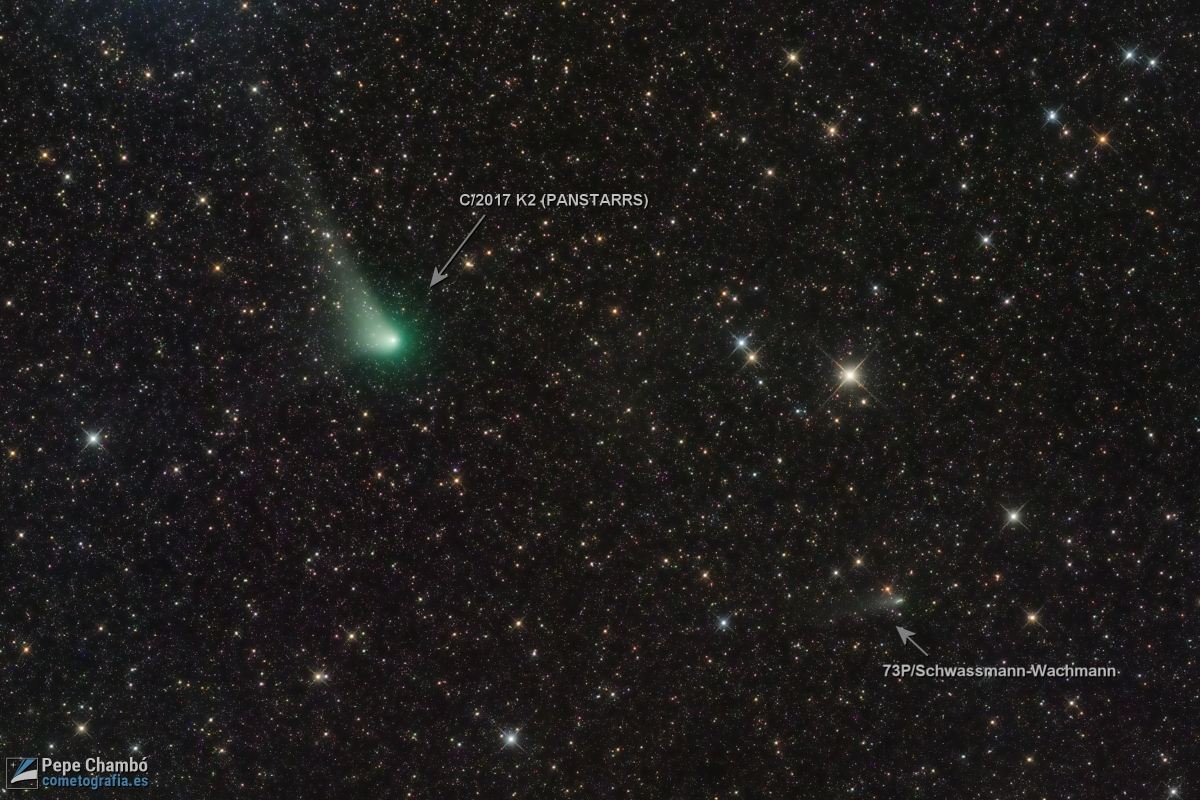08. October 2022
南天 ê 兩粒彗星

探索宇宙1!逐工會揀一幅無仝款 ê 影像抑是相片,𤆬你熟似咱這个迷人 ê 宇宙,閣有專業天文學者2為你3解說4。
- 原始文章:Two Comets in Southern Skies
- 影像來源 kah 版權:Jose J. Chambo (Cometografia)
- 台文翻譯:An-Li Tsai (NCU)
[漢羅] 南天 ê 兩粒彗星
彗星 C/2017 K2 (PanSTARRS 彗星) ê 近日點是 tī 12 月 20,伊這馬當咧飛過去。 伊掃過咱地球南半球 ê 天空,留予天文觀星者一个線索。 PanSTARRS 彗星 是 ùi 遙遠 ê Oort 雲 頭一擺飛來--ê。 這張是 9 月 21 翕--ê 深空影像,伊就 tī 倒爿頂懸遐,有 青色 ê 彗鬚 kah 差不多半度長 ê 白色塗粉尾溜。 這張天星滿滿 ê 相片內底閣有另外一粒 彗星 73P/Schwassmann-Wachmann 3 tī 天蠍座,伊 kah 倒爿下跤 ê PanSTARRS 彗星差不多有 1 度遠。 天文學家估計講,這粒頭一擺來揣咱 ê 彗星 C/2017 K2 (PanSTARRS 彗星) 進前蹛 tī Oort 雲 已經 300 萬年矣,伊綴雙曲線軌道咧行。 是講 咱其實 kah 彗星 Schwassmann-Wachmann 3 較熟講! 伊是週期性彗星,綴一个長株圓軌道咧行。 伊 ê 週期是 5.4 年,軌道範圍是 ùi 木星軌道外口到地球軌道附近。 PanSTARRS 彗星 tī 9 月 21 翕相 這暗才拄 ùi 咱 ê 天頂飛過,這陣伊離地球才 20 光分遠爾爾。 彗星 Schwassmann-Wachmann 3 離咱差不多是 7.8 光分遠,伊自 1995 年就開始解體矣。
[POJ] Lâm-thian ê nn̄g-lia̍p hūi-chhiu
Hūi-chhiu C/2017 K2 (PanSTARRS hūi-chhiⁿ) ê kīn-ji̍t-tiám sī tī 12 goe̍h 20, i chit-má tng leh poe kòe-khì. I sàu kòe lán Tē-kiû lâm-pòaⁿ-kiû ê thian-khong, lâu hō͘ thian-bûn koan-seng-chiá chi̍t-ê sòaⁿ-soh. PanSTARRS hūi-chhiu sī ùi iâu-oán ê Oort hûn thâu-chi̍t-pái poe--lâi--ê. Chit-tiuⁿ sī 9 goe̍h 21 hip--ê chhim-khong iáⁿ-siōng, i to̍h tī tò-pêng téng-koân, ū chhiⁿ-sek ê hūi-chhiu kah chha-put-to pòaⁿ tō͘ tn̂g ê pe̍h-sek thô͘-hún bóe-liu. Chit-tiuⁿ thiⁿ-chhiⁿ móa-móa ê siòng-phìⁿ lāi-té koh-ū lēng-gōa chi̍t-lia̍p hūi-chiⁿ 73P/Schwassmann-Wachmann 3 tī Thian-giat-chō, i kah tò-pêng ē-kha ê PanSTARRS hūi-chhiⁿ chha-put-to ū 1 tō͘ hn̄g. Thian-bûn ha̍k-ka kó͘-kè kóng, chit-lia̍p thâu-chi̍t-pái lâi chhōe lán ê hūi-chiⁿ C/2017 K2 (PanSTARRS hui-chhiⁿ) chìn-chêng tòa tī Oort hûn í-chêng 300 bān-nî--ah, i tòe siang-khiau-sòaⁿ kúi-tō leh kiâⁿ. Sī kóng lán kî-si̍t kah hūi-chiⁿ Schwassmann-Wachmann 3 khah se̍k7 kóng! I sī chiu-kî-sèng hūi-chiⁿ, tòe chi̍t-ê tn̂g-tu-îⁿ kúi-tō leh kiâⁿ. I ê chiu-kî sī 5.4 nî, kúi-tō hoān-ûi sī ùi Bo̍k-chhiⁿ gōa-kháu kàu Tē-kiû kúi-tō hū-kīn. PanSTARRS hūi-chiⁿ tī 9 goe̍h 21 hip-siòng chit-àm chiah tú ùi lán ê thiⁿ-téng poe--kòe, chit-chūn i lî Tē-kiû chiah 20 kng-hun hn̄g niā-niā. Hūi-chhiⁿ Schwassmann-Wachmann 3 lî lán chha-put-to sī 7.8 kng-hun hn̄g, i chū 1995 nî to̍h khai-sí kái-thé--ah.
[KIP] Lâm-thian ê nn̄g-lia̍p huī-tshiu
Huī-tshiu C/2017 K2 (PanSTARRS huī-tshinn) ê kīn-ji̍t-tiám sī tī 12 gue̍h 20, i tsit-má tng leh pue kuè-khì. I sàu kuè lán Tē-kiû lâm-puànn-kiû ê thian-khong, lâu hōo thian-bûn kuan-sing-tsiá tsi̍t-ê suànn-soh. PanSTARRS huī-tshiu sī uì iâu-uán ê Oort hûn thâu-tsi̍t-pái pue--lâi--ê. Tsit-tiunn sī 9 gue̍h 21 hip--ê tshim-khong iánn-siōng, i to̍h tī tò-pîng tíng-kuân, ū tshinn-sik ê huī-tshiu kah tsha-put-to puànn tōo tn̂g ê pe̍h-sik thôo-hún bué-liu. Tsit-tiunn thinn-tshinn muá-muá ê siòng-phìnn lāi-té koh-ū līng-guā tsi̍t-lia̍p huī-tsinn 73P/Schwassmann-Wachmann 3 tī Thian-giat-tsō, i kah tò-pîng ē-kha ê PanSTARRS huī-tshinn tsha-put-to ū 1 tōo hn̄g. Thian-bûn ha̍k-ka kóo-kè kóng, tsit-lia̍p thâu-tsi̍t-pái lâi tshuē lán ê huī-tsinn C/2017 K2 (PanSTARRS hui-tshinn) tsìn-tsîng tuà tī Oort hûn í-tsîng 300 bān-nî--ah, i tuè siang-khiau-suànn kuí-tō leh kiânn. Sī kóng lán kî-si̍t kah huī-tsinn Schwassmann-Wachmann 3 khah se̍k7 kóng! I sī tsiu-kî-sìng huī-tsinn, tuè tsi̍t-ê tn̂g-tu-înn kuí-tō leh kiânn. I ê tsiu-kî sī 5.4 nî, kuí-tō huān-uî sī uì Bo̍k-tshinn guā-kháu kàu Tē-kiû kuí-tō hū-kīn. PanSTARRS huī-tsinn tī 9 gue̍h 21 hip-siòng tsit-àm tsiah tú uì lán ê thinn-tíng pue--kuè, tsit-tsūn i lî Tē-kiû tsiah 20 kng-hun hn̄g niā-niā. Huī-tshinn Schwassmann-Wachmann 3 lî lán tsha-put-to sī 7.8 kng-hun hn̄g, i tsū 1995 nî to̍h khai-sí kái-thé--ah.
[English] Two Comets in Southern Skies
Heading for its closest approach to the Sun or perihelion on December 20, comet C/2017 K2 (PanSTARRS) remains a sight for telescopic observers as it sweeps through planet Earth's southern hemisphere skies. First time visitor from the remote Oort cloud this comet PanSTARRS sports a greenish coma and whitish dust tail about half a degree long at the upper left in a deep image from September 21. It also shares the starry field of view toward the constellation Scorpius with another comet, 73P/Schwassmann-Wachmann 3, seen about 1 degree below and left of PanSTARRS. Astronomers estimate that first time visitor comet C/2017 K2 (PanSTARRS) has been inbound from the Oort cloud for some 3 million years along a hyperbolic orbit. Schwassmann-Wachmann 3 is more familiar though. The periodic comet loops through its own elliptical orbit, from just beyond the orbit of Jupiter to the vicinity of Earth's orbit, once every 5.4 years. Just passing in the night, this comet PanSTARRS is about 20 light-minutes from Earth in the September 21 image. Seen to be disintegrating since 1995, Schwassmann-Wachmann 3 was about 7.8 light-minutes away.
詞彙學習
| 漢羅 | POJ | KIP | 華語 | English |
|---|---|---|---|---|
| 彗星 C/2017 K2 | hūi-chhiⁿ C jī-khòng-it-chhit K-two | huī-tshinn C jī-khòng-it-tshit K-two | 彗星 C/2017 K2 | C/2017 K2 |
| 近日點 | kīn-ji̍t-tiám | kīn-ji̍t-tiám | 近日點 | perihelion |
| 南半球 | lâm-pòaⁿ-kiû | lâm-puànn-kiû | 南半球 | southern hemisphere |
| Oort 雲 | Oort hûn | Oort hûn | 歐特雲 | Oort cloud |
| 塗粉尾溜 | thô͘-hún bóe-liu | thôo-hún bué-liu | 灰塵尾 | dust tail |
| 彗鬚 | hūi-chhiu | huī-tshiu | 彗髮 | coma |
| 天蠍座 | Thian-giat-chō | Thian-giat-tsō | 天蠍座 | Scorpius |
| 雙曲線 | siang-khiau-sòaⁿ | siang-khiau-suànn | 雙曲線 | hyperbolic |
| 週期性彗星 | chiu-kî-sèng hūi-chiⁿ | tsiu-kî-sìng huī-tsinn | 週期性彗星 | periodic comet |